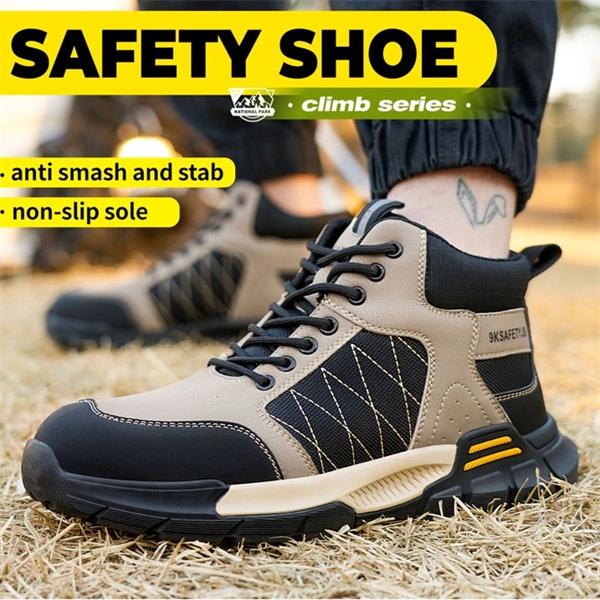
Kevlar to the Rescue: My Close Call with a Rusty Nail and How These Steel Toe Boots Saved My Foot
It’s funny how you never appreciate proper safety footwear until that split second when disaster nearly strikes. For me, that moment came on a rainy Tuesday afternoon at the Henderson construction site—a moment when I realized the difference between a minor incident and a major medical emergency was the Kevlar midsole in my work boots.
The Day a 4-Inch Rusty Nail Nearly Derailed My Career
The rain had been coming down steadily all morning, turning our residential construction site into something resembling a mud wrestling arena. As the site supervisor, I needed to check some framing work on the east side of the property where several bundles of reclaimed lumber had been delivered.
I remember stepping carefully around what looked like a relatively solid patch of ground when I felt it—that distinctive crunch followed by pressure against the bottom of my foot. Looking down, I saw a rusty, 4-inch framing nail that had worked its way up through a discarded board, now pressing directly into the sole of my boot.
In that moment, time seemed to slow down. My first thought wasn’t panic but rather a strange, detached curiosity: “Huh, I wonder if this is going to hurt.”
But it didn’t. The nail, despite pressing with my full body weight behind it, hadn’t penetrated through to my foot. When I carefully lifted my boot, the nail remained stuck in the board, bent at an angle that made it clear just how much force had been applied.
“You got lucky with those boots,” my coworker Jake muttered, looking at the nail that, by all rights, should have sent me to the emergency room for a tetanus shot and possibly weeks of antibiotics.
It wasn’t luck, though. It was Kevlar—the same material used in bulletproof vests, now saving construction workers from the everyday hazards that might otherwise end careers.
Why I Switched to Proper Safety Boots After 15 Years in the Industry
I didn’t always take footwear this seriously. For my first decade in construction, I cycled through whatever was on sale—usually cheap leather boots that wore out every six months. My standard line was “they’re just gonna get trashed anyway.”
That philosophy changed three years ago when a falling I-beam clipped my foot, crushing the side of my boot. The doctor told me I was “damn lucky” it hit the side rather than the top, or I’d have lost at least two toes. His exact words: “Next time, luck might not be on your side.”
That night, nursing a badly bruised foot that could have been much worse, I started researching proper safety footwear with the intensity of someone who’d just experienced a close call. What I discovered was that modern safety boots are engineering marvels that most workers (including myself) completely underappreciate.
After weeks of research, I invested in my first pair of Men’s Safety Steel Toe Work Boots with puncture-resistant Kevlar midsoles. The price tag made me wince, but as my father always said, “You can’t put a price on keeping all your appendages.”
Breaking Down the Real-World Performance: 18 Months of Hard Testing
Over the past year and a half, these boots have become my trusted companions across dozens of job sites. Here’s how they’ve performed in conditions that would have destroyed my previous footwear:
Steel Toe Protection: Tested by Accident (Twice)
The first real test came just two months after purchase. I was helping position a granite countertop when one corner slipped. The edge—weighing approximately 60 pounds—landed directly on my right toe.
Instead of a crushed foot, I experienced only moderate pressure. The steel toe distributed the impact across the entire front of the boot, turning what should have been an emergency room visit into a “walk it off” moment. According to ANSI standards, these steel toes can withstand up to 200J of impact force—roughly equivalent to dropping a 45-pound weight from waist height.
Six months later, a similar incident with a dropped pallet jack reinforced my appreciation for proper toe protection. The site medic actually asked to inspect my foot, expecting at minimum severe bruising. He was visibly surprised to find nothing—not even discomfort.
Kevlar Midsole: The Unsung Hero
The rusty nail incident wasn’t the only time the puncture resistance saved me. Working on demolition at the Parkview site last fall, we discovered the previous contractor had used staples rather than nails in some sections of subflooring. These staples, now rusted and exposed, created a virtual minefield of puncture hazards.
By day’s end, I had pulled three separate staples from the bottom of my boots—none of which had penetrated through to my foot. One coworker wearing traditional work boots wasn’t so fortunate, ending his day with a tetanus booster and antibiotics.
The Kevlar technology isn’t just hype—it’s engineered to resist penetration forces exceeding 1,100 Newtons. For context, that’s roughly the force generated by a 220-pound person stepping directly onto a nail.
Water Resistance: The Daily Comfort Factor
Perhaps the most appreciated feature during Seattle’s notorious rainy season has been the water-resistant leather upper. Prior to these boots, my routine included keeping spare socks in my truck—a necessity after working in wet conditions.
During the Lakeside project, where inadequate drainage left us working in nearly constant shallow water, these boots kept my feet remarkably dry. While water resistance isn’t as dramatic as puncture protection, the daily comfort of dry feet significantly reduces fatigue during 10-hour shifts.
The leather has maintained its water-resistant properties even after 18 months of harsh conditions, with only minimal conditioning required every few months.
Anti-Slip Outsole: Preventing the Invisible Accidents
Construction site injuries often come from dramatic incidents, but the silent danger is always slips and falls. The rubber outsole on these boots has demonstrated exceptional grip across varied surfaces:
- Fresh concrete (notoriously slippery when wet)
- Metal scaffolding during light rain
- Oil-contaminated warehouse floors
- Icy walkways during winter framing work
The tread pattern maintains its effectiveness even when caked with mud—a design element I’ve come to appreciate during Pacific Northwest winters. According to BLS (Bureau of Labor Statistics) data, slips and falls account for nearly 20% of all construction injuries, making reliable traction a safety feature that doesn’t get enough attention.
Comfort: The Unexpected Benefit That Keeps Me Wearing Them
Safety features aside, what’s surprised me most is the comfort level. Previous safety boots left me counting the minutes until I could change into normal shoes. These boots, despite their robust protection, feel remarkably like everyday footwear after a brief break-in period.
The padded collar prevents the rubbing that typically causes ankle blisters, while the lace-up design allows adjustments throughout the day as feet naturally swell during long shifts.
What’s particularly impressive is that despite 18 months of continuous wear (often 50+ hours weekly), the interior cushioning has maintained approximately 80% of its original support. My previous boots would be compressed and uncomfortable by the 6-month mark.
Industry-Specific Performance: Real-World Applications
As someone who moves between various construction specialties, I’ve tested these boots across multiple working environments. Here’s how they perform in specific applications:
| Industry | Performance Notes | Key Beneficial Features |
|---|---|---|
| Framing/Carpentry | Excellent protection from dropped lumber and protruding fasteners | Steel toe, puncture resistance |
| Concrete Work | Superior traction on wet surfaces; protection from heavy form materials | Anti-slip outsole, water resistance |
| Electrical/HVAC | Comfortable for extended periods in cramped spaces (attics, crawlspaces) | Lightweight design, flexible midsole |
| Demolition | Outstanding protection from hidden hazards in existing structures | Puncture resistance, durable upper |
| Roofing | Good grip on steep surfaces; protection from falling tools | Anti-slip outsole, steel toe protection |
The Economics of Quality Safety Footwear: A Foreman’s Perspective
As a site supervisor responsible for a crew of 12, I’ve become something of an evangelist for proper PPE—especially footwear. The math is simple and compelling:
- Average cost of quality safety boots: $150-200
- Average worker compensation claim for foot injury: $10,000+
- Average lost work time from serious foot injury: 6-8 weeks
Beyond the numbers, there’s the human factor. I’ve witnessed firsthand how a serious foot injury derailed a promising apprentice’s career, leaving him with chronic pain and limited mobility. That’s something no paycheck can compensate for.
When crew members balk at the upfront investment, I share my own experiences. Nothing convinces quite like the story of the rusty nail that should have sent me to the ER but didn’t.
Common Questions About Men’s Safety Steel Toe Work Boots
How long should quality safety boots last under daily use?
With proper care, premium safety boots should provide full protection for 12-18 months of daily wear in harsh conditions. The outer materials may show wear earlier, but the critical protective elements (steel toe, puncture protection) maintain their integrity longer. I’ve found rotation between two pairs can extend this to nearly 2 years per pair.
Do steel toe boots actually cause more foot injuries when heavy objects are dropped?
This is a common myth I’ve heard repeated on job sites. According to OSHA research, properly fitted steel toe boots distribute impact forces rather than concentrating them. In my personal experience with two significant impacts, the steel toe prevented injury rather than causing it.
Are these boots suitable for electrical work where shock hazards exist?
While these particular boots offer excellent puncture and impact protection, electricians should specifically look for boots meeting ASTM F2413-18 standards with electrical hazard (EH) protection. These are designed with non-conductive materials in the toe cap and soles to reduce electrical shock risk.
How do you maintain the water resistance over time?
I’ve found that applying a quality leather conditioner every 2-3 months maintains water resistance effectively. For boots used in extremely wet conditions, supplemental waterproofing agents containing silicone or beeswax can be applied to the upper material and seams.
Can the puncture resistance be compromised without visible damage?
This is an important safety consideration. While Kevlar midsoles are extremely durable, repeated puncture attempts in the same location can gradually weaken the material. After any significant puncture attempt (like my rusty nail incident), I inspect both the outer sole and the interior footbed for any signs of penetration. When in doubt, replacement is the safest option.
Final Thoughts: Why I Won’t Work Without Proper Protection Again
That rusty nail could have been a turning point in my career—the kind that leads to infection, complications, and potentially weeks of lost income. Instead, it became a powerful reminder of why proper safety equipment isn’t optional in construction.
Having experienced the difference between adequate and inadequate protection firsthand, I can confidently say the investment in quality Men’s Safety Steel Toe Work Boots pays dividends daily. Beyond the dramatic incidents, it’s the everyday comfort and peace of mind that make them worth every penny.
For anyone spending their days in environments where foot hazards are a constant companion, proper safety footwear isn’t a luxury—it’s a necessity. The difference between going home intact and a trip to the emergency room might just be that layer of Kevlar between your foot and a rusty nail.
Ready to give your feet the protection they deserve? Check out these Men’s Safety Steel Toe Work Boots that saved my foot from a nasty puncture wound! Don’t wait for your close call to upgrade your safety footwear. 👷♂️🔒
